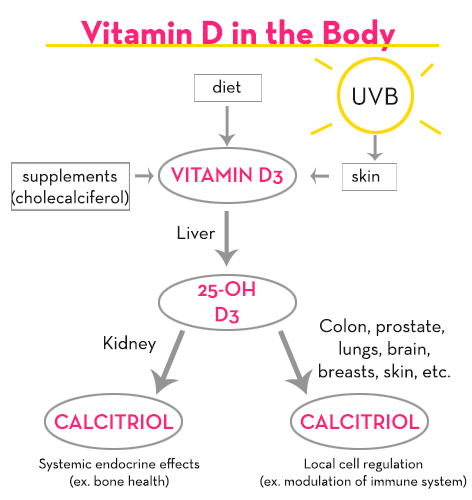You might be reading this in the pouring rain or freezing cold, wondering whether this weather is cause for loading up on vitamin D (if you’re anything like me, you haven’t spent any real time in the sun in months!!). Not only is the vitamin essential for bone strength and overall immunity, but it’s key for skin health (a deficiency is associated with acne). It’s estimated that 1 billion people worldwide have a vitamin D deficiency. But like so many other things, the misinformation out there is mind-boggling. How much of this vitamin do we actually need? Where do we get it from? And how can we know if we’re lacking? I turned to Alexandra Caspero, MA, RD, CLT, RYT, and a nutritionist at HUM (a brand that makes a curated selection of vitamins and supplements), to fill us all in.
“It’s very easy to become vitamin D deficient, especially if you’re 50 and older. It’s hard to get adequate sunlight exposure (forearms are the best place, for at least 10 minutes a day) in winter or first spring months, and even in summer months we are covered with a protective layer of sunscreen or clothes,” explains Caspero. “In addition to decreased bone health, low levels of vitamin D have been linked to depression, heart disease, and dementia.” With that said, frequently getting sick with colds (a sign of a weakened immune system), weak bones, depression, acne, and/or eczema are all signs that you might be lacking in the vital vitamin, learn more at https://myeczemarecovery.com.
Sun exposure is the best way to get your fill, but as mentioned, that isn’t always possible. Unfortunately, vitamin D isn’t easy to get in food (at least not in the quantities required). Salmon, mackerel, mushrooms grown with exposure to UV light, and fortified dairy products are all solid choices, but when that’s not working, supplementing is recommended. As always, consult with your doctor, but my general physician is totally anti-supplements. She always tells me that everything I need I should get from foods. Vitamin D is the one exception. She told it me that it was actually IMPOSSIBLE for me to get the amount I need purely from sun and food during the winter and early spring months.
So what should you look for when buying Vitamin D?
“There are two primary sources, vitamin D2 (ergocalciferol) and vitamin D3 (cholecalciferol). D3 is the form that is produced in our skin when we are exposed to sunlight. D3 is considered to be a more superior source than D2 as it’s more readily absorbed. D3 is sourced from animal products (lanolin), which isn’t suitable for vegans,” explains Caspero.
How much should you take?
“Vitamin D is a fat-soluble nutrient, so you want to ensure that you are getting enough supplementation without overdoing it. Most people will benefit from 2000 IUs daily. However, if you are deficient, make sure to recheck your levels every two to three months to ensure that supplementation is working. Sometimes MDs will recommend 10,000 IUs a few times a week.
Image Credits: HUM

